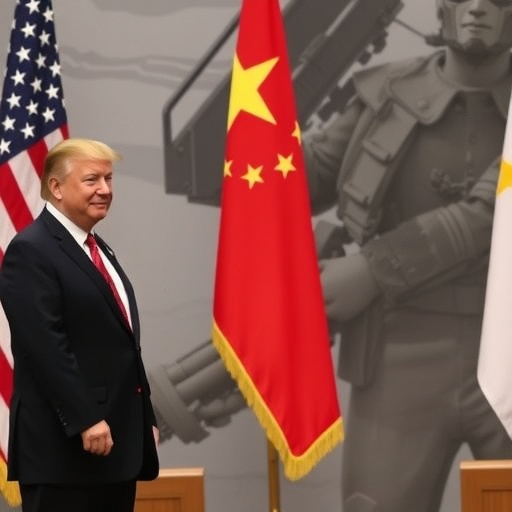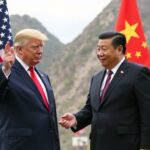US-China Trade Tensions Ease as Trump Prepares for High-Stakes Xi Jinping Meeting at ASEAN Summit
In a surprising turn amid years of escalating US-China trade tensions, diplomatic signals indicate a potential thaw as President Donald Trump gears up for a crucial face-to-face with Chinese President Xi Jinping at the upcoming ASEAN Summit. This development comes on the heels of the United States signing groundbreaking economic frameworks with Cambodia, Thailand, and Malaysia, aimed at bolstering secure supply chains for critical minerals essential to global technology and defense sectors.
The move underscores a strategic diversification effort by the Trump administration to reduce reliance on Chinese-dominated mineral supplies, which have been a flashpoint in the ongoing trade frictions. Sources close to the White House describe the pre-summit overtures as “a calculated step toward de-escalation,” potentially averting further tariffs and fostering bilateral cooperation. With the ASEAN Summit in Bangkok set to convene next month, all eyes are on how this meeting could reshape the contours of US-China economic relations.
Trade data from the U.S. Census Bureau reveals that bilateral trade volumes dipped by 12% in the first half of this year compared to pre-tariff levels, highlighting the urgency for resolution. Economists estimate that easing these tensions could inject up to $500 billion back into global markets over the next five years, according to a recent report from the Peterson Institute for International Economics.
Trump’s Southeast Asia Outreach Secures Critical Mineral Lifelines
At the heart of the easing US-China trade tensions lies the Trump administration’s aggressive pivot toward Southeast Asia. In a series of high-profile announcements this week, the U.S. inked comprehensive economic pacts with Cambodia, Thailand, and Malaysia, focusing on the extraction, processing, and supply of rare earth elements and other critical minerals. These materials—vital for everything from electric vehicle batteries to semiconductor chips—have long been controlled by China, which dominates over 80% of global production, per U.S. Geological Survey data.
The frameworks, valued at an estimated $15 billion in initial investments, include joint ventures for mining operations in Cambodia’s Rovieng district, where untapped deposits of neodymium and praseodymium could yield 20,000 tons annually. Thailand’s commitments center on refining facilities in the eastern economic corridor, promising to process 50% more lithium by 2025, while Malaysia’s deals emphasize sustainable cobalt sourcing from Sabah state mines.
“This is about building resilient supply chains that don’t leave America vulnerable,” Trump stated during a press briefing at the White House. “We’re not just talking trade; we’re securing our future against any adversary.” The pacts also incorporate environmental safeguards and labor standards, addressing criticisms from human rights groups about exploitative practices in the region.
Industry leaders have hailed the move. Lisa Johnson, CEO of TechSupply Global, a major U.S. importer of rare earths, remarked, “These agreements could cut our costs by 25% and timelines by months, all while diversifying away from Beijing’s grip.” However, challenges remain: Cambodia’s infrastructure lags, with only 40% of rural roads paved, potentially delaying project rollouts.
Xi Jinping’s Response Signals Willingness for Dialogue
As preparations for the ASEAN Summit intensify, President Xi Jinping’s recent statements suggest a reciprocal interest in cooling US-China trade tensions. In a speech at the Boao Forum for Asia earlier this month, Xi emphasized “win-win cooperation” and called for an end to “protectionist barriers that harm global prosperity.” Analysts interpret this as a direct nod to the Trump-Xi meeting, where topics like intellectual property rights and market access are expected to dominate discussions.
Beijing has already taken concrete steps, including a 10% reduction in retaliatory tariffs on U.S. agricultural exports like soybeans and pork, which had previously cost American farmers $27 billion since 2018, according to the American Farm Bureau Federation. Chinese state media, such as Xinhua, has covered the U.S. deals with Southeast Asian nations neutrally, framing them as “regional opportunities” rather than direct threats.
Diplomatic insiders reveal that Xi’s team has proposed including tech transfer protocols in the summit agenda, potentially allowing U.S. firms greater access to China’s vast consumer market. “Xi is playing the long game,” said Dr. Elena Ramirez, a China expert at the Brookings Institution. “He knows that alienating the U.S. entirely could push more allies toward diversification, so this meeting is his chance to steer the narrative back to partnership.”
Yet, skepticism persists. The U.S. Trade Representative’s office has flagged ongoing issues with China’s subsidies to state-owned enterprises, which distort markets for critical minerals. A World Trade Organization dispute filed last quarter accuses Beijing of unfair practices in lithium processing, adding layers to the pre-summit negotiations.
ASEAN Summit Emerges as Key Arena for US-China Diplomacy
The ASEAN Summit in Bangkok is no ordinary gathering; it’s poised to become the epicenter of US-China trade tensions resolution efforts. Hosted annually by the Association of Southeast Asian Nations, this year’s event—scheduled for November 15-18—will draw over 20 world leaders, including Trump and Xi, amid a backdrop of regional economic integration via the Regional Comprehensive Economic Partnership (RCEP).
For the U.S., the summit represents a multilateral platform to rally ASEAN support for its supply chain initiatives. Thailand, as host, has pledged to mediate discussions on mineral trade, leveraging its position as a hub for electronics manufacturing. Cambodia and Malaysia, fresh off their U.S. deals, are expected to advocate for balanced US-China engagement to avoid being caught in the crossfire.
Historical context adds weight: The 2018 ASEAN Summit saw initial Trump-Xi talks that led to a fragile truce, only for tensions to flare again over Huawei and TikTok bans. This time, with global inflation at 7.5% and supply disruptions from the Ukraine conflict, stakes are higher. A joint statement from the summit could outline phased tariff reductions, targeting a 50% cut in non-essential duties by mid-2024.
Local impacts are already visible. In Malaysia, U.S. investments have created 5,000 jobs in Penang’s tech parks, boosting GDP growth projections by 1.2%. Thai Prime Minister Srettha Thavisin noted, “ASEAN benefits when superpowers collaborate, not compete destructively.” Protests from Chinese expatriate groups in Bangkok highlight the sensitivities, but security measures ensure smooth proceedings.
Broader Economic Ripples from Easing Trade Frictions
The potential easing of US-China trade tensions extends far beyond minerals, promising ripple effects across global economies. Wall Street reacted positively, with the Dow Jones Industrial Average climbing 2.3% following the framework announcements, driven by gains in mining stocks like Freeport-McMoRan and Albemarle.
For consumers, this could mean lower prices on EVs and smartphones; critical mineral costs have surged 40% since 2020 due to trade uncertainties, per BloombergNEF. U.S. manufacturers, hit hard by tariffs averaging 25% on Chinese imports, stand to save $100 billion annually if deals materialize. China’s economy, grappling with 5.2% growth forecasts, would gain from stabilized export channels, particularly in machinery and renewables.
Experts like Paul Krugman, Nobel laureate economist, warn of pitfalls: “Diversification is smart, but it can’t replace dialogue. A Trump-Xi breakthrough could prevent a recessionary spiral.” Environmental advocates push for green clauses in the pacts, noting that Southeast Asian mining often leads to deforestation—over 1 million hectares lost yearly in Indonesia alone.
Geopolitically, the shift bolsters U.S. alliances in the Indo-Pacific, countering China’s Belt and Road Initiative, which has invested $1 trillion across 150 countries. Yet, it risks alienating smaller partners if benefits skew toward majors like Thailand.
Outlook for Trump-Xi Meeting: Pathways to Lasting Stability
Looking ahead, the Trump-Xi meeting at the ASEAN Summit could mark a watershed in US-China relations, with pathways to lasting trade stability on the horizon. Optimistic scenarios include a “Phase Two” trade agreement, building on the 2020 deal, that addresses subsidies and digital trade, potentially unlocking $300 billion in new bilateral investments by 2030.
Challenges abound: U.S. midterm elections could harden Trump’s stance, while Xi faces domestic pressures from youth unemployment at 20%. Still, multilateral forums like ASEAN offer neutral ground for breakthroughs. Post-summit, follow-up working groups on minerals and tariffs are anticipated, with the U.S. pushing for WTO reforms to enforce compliance.
Global markets await outcomes that could redefine supply chains for decades. As one State Department official put it, “This isn’t just about Trump and Xi—it’s about ensuring the world’s engine doesn’t stall.” With stakes this high, the Bangkok talks promise to be a defining moment in international trade dynamics.








